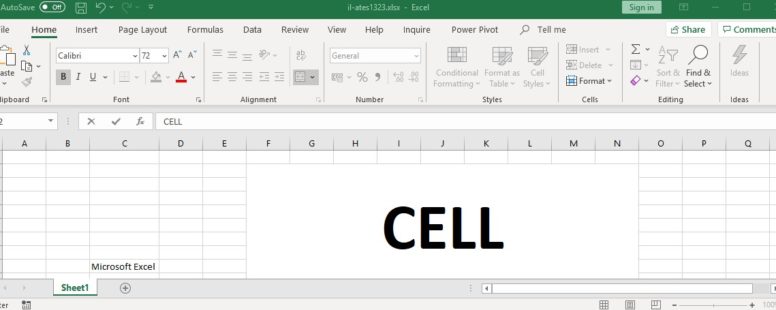It returns information about the formatting, location, or contents of a cell.
The syntax of the function is the following:
CELL(info_type, [reference])
info_type: The type of cell information we need.
[reference]: Optional. The cell that we need information about. If omitted the info_type returned is about the last cell that was changed. If the reference is a range of cells the information returned is about the cell in the upper left corner of the range.
| info_type | Returns |
| “address” | Reference of the first cell in reference, as text |
| “col” | Column number of the cell in reference |
| “color” | The value 1 if the cell is formatted in color for negative values; otherwise returns 0 (zero) |
| “contents” | Value of the upper-left cell in reference; not a formula |
| “filename” | Filename (including full path) of the file that contains reference, as text. Returns empty text (“”) if the worksheet that contains reference has not yet been saved |
| “format” | Text value corresponding to the number format of the cell. (see table below) |
| “parentheses” | The value 1 if the cell is formatted with parentheses for positive or all values; otherwise returns 0 |
| “prefix” | Text value corresponding to the “label prefix” of the cell. Returns single quotation mark (‘) if the cell contains left-aligned text, double quotation mark (“) if the cell contains right-aligned text, caret (^) if the cell contains centered text, backslash () if the cell contains fill-aligned text, and empty text (“”) if the cell contains anything else |
| “protect” | The value 0 if the cell is not locked; otherwise returns 1 if the cell is locked |
| “row” | Row number of the cell in reference |
| “type” | Text value corresponding to the type of data in the cell. Returns “b” for blank if the cell is empty, “l” for label if the cell contains a text constant, and “v” for value if the cell contains anything else |
| “width” | Column width of the cell, rounded off to an integer. Each unit of column width is equal to the width of one character in the default font size |
This is the explanation of the format info_type.
It returns “-” at the end of the text value if the cell is formatted in color for negative values. Returns “()” at the end of the text value if the cell is formatted with parentheses for positive or all values.
In more detail:
| format | Returns |
|
General |
“G” |
|
0 |
“F0” |
|
#,##0 |
“,0” |
|
0.00 |
“F2” |
|
#,##0.00 |
“,2” |
|
$#,##0_);($#,##0) |
“C0” |
|
$#,##0_);[Red]($#,##0) |
“C0-“ |
|
$#,##0.00_);($#,##0.00) |
“C2” |
|
$#,##0.00_);[Red]($#,##0.00) |
“C2-“ |
|
0% |
“P0” |
|
0.00% |
“P2” |
|
0.00E+00 |
“S2” |
|
# ?/? or # ??/?? |
“G” |
|
m/d/yy or m/d/yy h:mm or mm/dd/yy |
“D4” |
|
d-mmm-yy or dd-mmm-yy |
“D1” |
|
d-mmm or dd-mmm |
“D2” |
|
mmm-yy |
“D3” |
|
mm/dd |
“D5” |
|
h:mm AM/PM |
“D7” |
|
h:mm:ss AM/PM |
“D6” |
|
h:mm |
“D9” |
|
h:mm:ss |
“D8” |
Click on the button to practice using this function, with the help of our Online Assessment Tool:
Here is an example of how to use the CELL function:
In the cell Α1 show the row of the cell C9 and in the cell B1 the column of the cell C9, with the use of the proper function.
